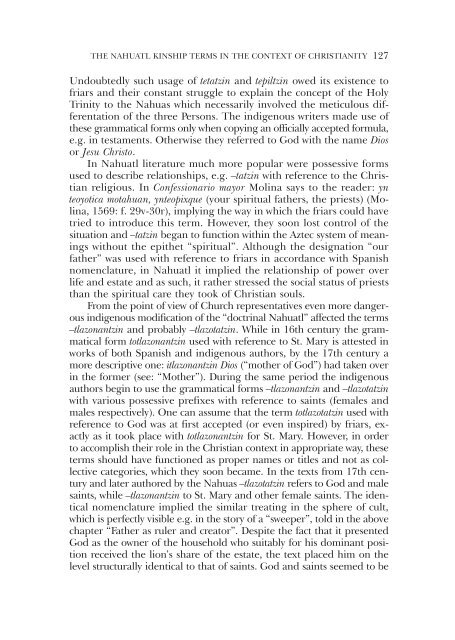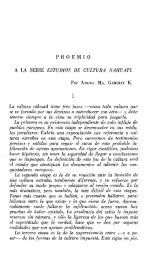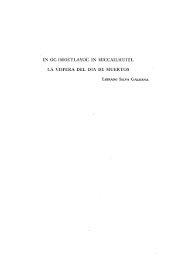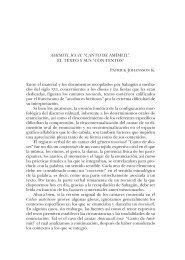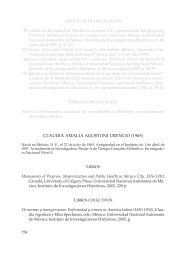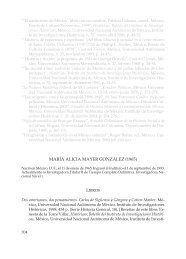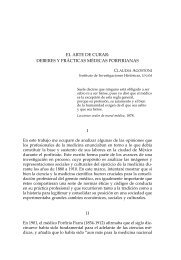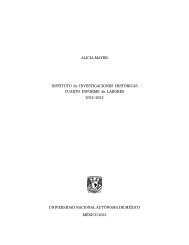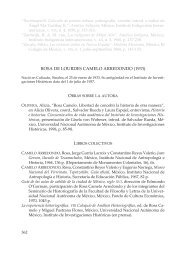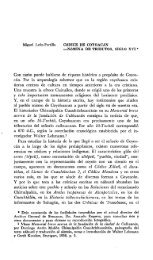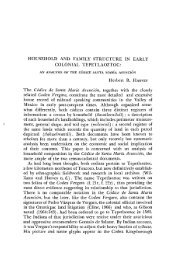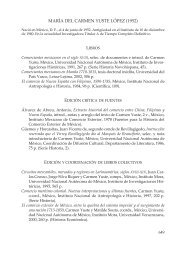“HOLY FAMILY”. THE NAHUATL KINSHIP TERMS IN THE ...
“HOLY FAMILY”. THE NAHUATL KINSHIP TERMS IN THE ...
“HOLY FAMILY”. THE NAHUATL KINSHIP TERMS IN THE ...
You also want an ePaper? Increase the reach of your titles
YUMPU automatically turns print PDFs into web optimized ePapers that Google loves.
The Nahuatl kinship terms in the context of Christianity 127<br />
Undoubtedly such usage of tetatzin and tepiltzin owed its existence to<br />
friars and their constant struggle to explain the concept of the Holy<br />
Trinity to the Nahuas which necessarily involved the meticulous differentation<br />
of the three Persons. The indigenous writers made use of<br />
these grammatical forms only when copying an officially accepted formula,<br />
e.g. in testaments. Otherwise they referred to God with the name Dios<br />
or Jesu Christo.<br />
In Nahuatl literature much more popular were possessive forms<br />
used to describe relationships, e.g. –tatzin with reference to the Christian<br />
religious. In Confessionario mayor Molina says to the reader: yn<br />
teoyotica motahuan, ynteopixque (your spiritual fathers, the priests) (Molina,<br />
1569: f. 29v-30r), implying the way in which the friars could have<br />
tried to introduce this term. However, they soon lost control of the<br />
situation and –tatzin began to function within the Aztec system of meanings<br />
without the epithet “spiritual”. Although the designation “our<br />
father” was used with reference to friars in accordance with Spanish<br />
nomenclature, in Nahuatl it implied the relationship of power over<br />
life and estate and as such, it rather stressed the social status of priests<br />
than the spiritual care they took of Christian souls.<br />
From the point of view of Church representatives even more dangerous<br />
indigenous modification of the “doctrinal Nahuatl” affected the terms<br />
–tlazonantzin and probably –tlazotatzin. While in 16th century the grammatical<br />
form totlazonantzin used with reference to St. Mary is attested in<br />
works of both Spanish and indigenous authors, by the 17th century a<br />
more descriptive one: itlazonantzin Dios (“mother of God”) had taken over<br />
in the former (see: “Mother”). During the same period the indigenous<br />
authors begin to use the grammatical forms –tlazonantzin and –tlazotatzin<br />
with various possessive prefixes with reference to saints (females and<br />
males respectively). One can assume that the term totlazotatzin used with<br />
reference to God was at first accepted (or even inspired) by friars, exactly<br />
as it took place with totlazonantzin for St. Mary. However, in order<br />
to accomplish their role in the Christian context in appropriate way, these<br />
terms should have functioned as proper names or titles and not as collective<br />
categories, which they soon became. In the texts from 17th century<br />
and later authored by the Nahuas –tlazotatzin refers to God and male<br />
saints, while –tlazonantzin to St. Mary and other female saints. The identical<br />
nomenclature implied the similar treating in the sphere of cult,<br />
which is perfectly visible e.g. in the story of a “sweeper”, told in the above<br />
chapter “Father as ruler and creator”. Despite the fact that it presented<br />
God as the owner of the household who suitably for his dominant position<br />
received the lion’s share of the estate, the text placed him on the<br />
level structurally identical to that of saints. God and saints seemed to be


